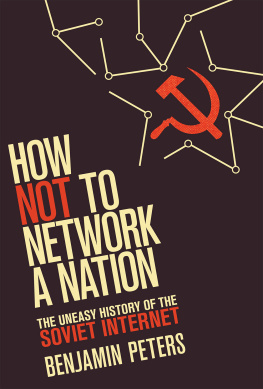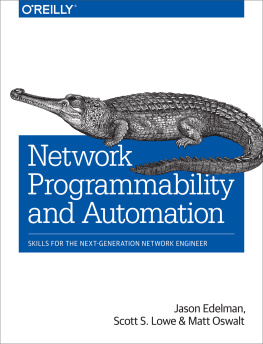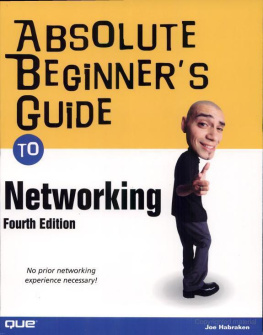NATION
T En Pf
BENJAMIN PETERS
How Not to Network a Nation
Information Policy
edited by Sandra Braman
The Information Policy Series publishes research on and analysis of signifi-cant problems in the field of information policy, including state-law-soci-ety interactions as well as decisions and practices that enable or constrain information, communication, and culture irrespective of the legal siloes in which they have traditionally been located. Defining information policy as all laws, regulations, and decision-making principles that affect any form of information creation, processing, flows, and use, the series looks at the formal decisions, decision-making processes, and entities of government; the formal and informal decisions, decision-making processes, and entities of private- and public-sector agents that are capable of affecting the nature of society; and the cultural habits and predispositions that support and sus-tain government and governance. The parametric functions of information policy at the boundaries of social, informational, and technological systems are of global importance because they provide the context for all communi-cations, interactions, and social processes.
Virtual Economies: Design and Analysis , Vili Lehdonvirta and Edward Cas-tronova
Traversing Digital Babel: Information, e-Government, and Exchange , Alon Peled
Chasing the Tape: Information Law and Policy in Capital Markets , Onnig H. Dombalagian
Policy for Computing Infrastructure: Governance of the Cloud , edited by Christopher S. Yoo and Jean-Franois Blanchette
Privacy on the Ground: Driving Corporate Behavior in the United States and Eu-rope , Kenneth A. Bamberger and Deirdre K. Mulligan
How Not to Network a Nation: The Uneasy History of the Soviet Internet , Benjamin Peters
How Not to Network a Nation
The Uneasy History of the Soviet Internet
Benjamin Peters
The MIT Press
Cambridge, Massachusetts London, England
2016 Massachusetts Institute of Technology
All rights reserved. No part of this book may be reproduced in any form by any electronic or mechanical means (including photocopying, recording, or information storage and retrieval) without permission in writing from the publisher.
The documents shown in Figures 4.1, 4.34.13, and 4.154.19 are held in the personal archive of Vera Viktorevna Glushkova and are reproduced here with permission.
This book was set in Stone by the MIT Press. Printed and bound in the United States of America.
Library of Congress Cataloging-in-Publication Data
Names: Peters, Benjamin, 1980- author.
Title: How not to network a nation : the uneasy history of the Soviet
internet / Benjamin Peters.
Description: Cambridge, MA : MIT Press, [2015] | Series: The information
policy | Includes bibliographical references and index.
Identifiers: LCCN 2015038371 | ISBN 9780262034180 (hardcover : alk. paper)
Subjects: LCSH: Computer networksSoviet UnionHistory. | Internetworking
(Telecommunication)ResearchSoviet UnionHistory.
Classification: LCC TK5102.3.S68 P48 2015 | DDC 384.30947/09045dc23
LC record available at http://lccn.loc.gov/2015038371
10 9 8 7 6 5 4 3 2 1
Joli Jensen, Michael Schudson, Fred Turner, Gary Browning Four mentors at four schools
Contents
Series Editors Introduction ix
Prologue xi
Introduction 1
A Global History of Cybernetics 15
2 Economic Cybernetics and Its Limits 57
3 From Network to Patchwork: Three Pioneering Network Projects That Didnt, 1959 to 1962 81
4 Staging the OGAS, 1962 to 1969 107
5 The Undoing of the OGAS, 1970 to 1989 159
Conclusion 191
Acknowledgments 207
Appendix A: Basic Structure of the Soviet Government 213
Appendix B: Annotated List of Slavic Names 215
Appendix C: Network and Other Project Acronyms 219
Notes 221
Bibliography 259
Index 287
Series Editors Introduction
Sandra Braman
In this first-ever book-length treatment of early Soviet intelligent network design history, Benjamin Peters uses uncanniness as a method. He makes use, that is, of the disorientation that results when the familiar is encoun-tered in an unfamiliar context, broadening and deepening what we believe that we know about the familiar. This can be a dangerous endeavor. Avatar designers and others fear the uncanny valleywhere the nonhuman is so close to the human that the difference cannot be discernedbecause that is literally too close for viewer/user comfort. Thats different, they say in those cultures with traditional concerns about trolls, those who look like people but in fact are not.
Historically, the uncanny other was supernatural and not necessarily to be trusted with matters of this world. For Peters, the other is the Soviet Union. What he found is based on original multilingual archival research and oral interviews with those who were involved in the design processes. Peters describes what he sees as the capitalist features of the Soviet world that undermined its networking efforts and what he views as the social-ist characteristics of the United States that produced the Internet. On the face of it, this suggests deep contradictions within capitalist and socialist systems that belie the claimed and apparent differences between the two blocs. But even those concerned with cybersecurity acknowledge that it can be difficult to identify the other in the network environment. What was the uncanny valley in this analytical zone?
For those who think about the information economy, differences between the East and West are indiscernible. Cristiano Antonellis (1992) seminal insights into the nature of the information economy, in which coopera-tion and coordination are as important asor more important thancom-petition for long-term economic success were inductively developed from
x Series Editors Introduction
detailed studies of the practices and activities of transnational corporations on both sides of the iron curtain (many funded by the unfortunately short-lived United Nations Center on Transnational Corporations). What Peters presents as counterintuitive actually provides further evidence of the transi-tion to a global information economy in which ideological differences may still provide motivations but not explanations. Work of this kind, which looks across political environments, is particularly valuable as we struggle to make policy for a world in which network politics is genuinely global even though state-centric geopolitical distinctions remain.
Theoretical pluralism has been familiar since the 1980s, but on reading Peters one suddenly realizes that most of those who take such an approach tend to prefer particular types of causal probability even as they roam across theories and disciplines. Peters is not only interdisciplinary but also travels across the levels and qualities of the likelihood that any given causal factor will be determinative in a given circumstance. In this history of early Soviet network design efforts, Peters ranges from unpacking institutional rigidi-ties that did successfully shape knowledge production and use to focusing attention on contingencies that can radically affect ultimate outcomes. His heterarchical approach to policy analysis importantly reminds us of the need to examine the interplay among decision-making processes as well as among players. And Peters returns again and again to the centrality of ideas in policymaking, devoting a full chapter to the history of cybernetics in the Soviet Union during the period covered.
Oddly, according to the OED , the notion of the uncanny came into written use a century before the word canny was seen. This may be an artifact of the processes by which materials survive, but it is still interesting. Peterss multilingual archival research and oral interviews with individuals involved in the Soviet efforts have yielded a picture of network conceptu-alization and decision-making processes fascinating not only in their own right but also for what they offer to those who study and live with intelligent networks in other parts of the world. We are the other, in the global network. With this book, Peters deepens our ken of networksa funda-ment of information policy since at least the 1830s and the telegraphand brings their study into the next generation.








